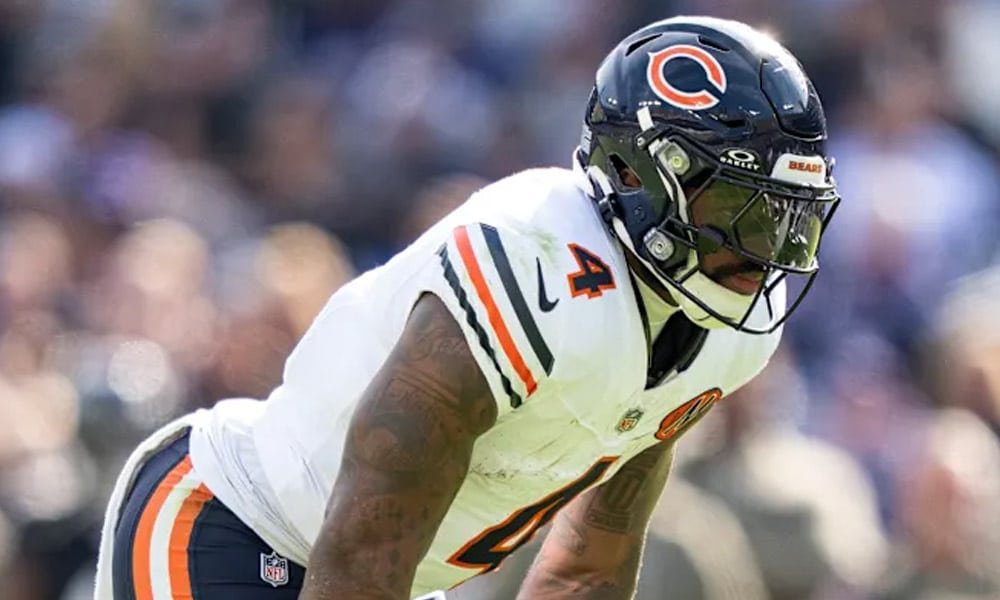Sports
Minnesota Vikings vs Chicago Bears Match Player Stats
Published
2 weeks agoon
By
Alexander
The Monday Night Football opener on September 8, 2025, gave fans one of the most exciting games of the new NFL season. The Minnesota Vikings faced the Chicago Bears at Soldier Field, and what started as a quiet game turned into a wild finish.
The Vikings came back from an 11-point fourth-quarter deficit to beat the Bears 27-24 in front of more than 58,000 fans. It was a night full of drama, mistakes, and history — especially for rookie quarterback J.J. McCarthy, who made his long-awaited NFL debut.
In this article, we’ll go through all the Minnesota Vikings vs Chicago Bears match player stats, key plays, performances, and everything that made this game unforgettable.
Score Summary: How the Game Unfolded
The Bears led almost the entire night. They were in control through three quarters, building a 17-6 lead after a 74-yard interception return by Nahshon Wright. But the Vikings completely flipped the story in the fourth quarter.
They scored 21 points in just over 10 minutes — something that seemed impossible after struggling for most of the game. McCarthy threw two touchdown passes and ran for another, helping Minnesota take the lead for good.
Here’s how the scoring looked by quarter:
| Quarter | Vikings | Bears |
|---|---|---|
| 1st | 0 | 7 |
| 2nd | 6 | 3 |
| 3rd | 0 | 7 |
| 4th | 21 | 7 |
| Final | 27 | 24 |
It was a true comeback story — from being 0-for-8 on third downs to scoring on three straight drives when it mattered most.
Vikings vs Bears Player Stats: Quick Overview
When we look at the full Minnesota Vikings vs Chicago Bears match player stats, both teams were quite close on paper.
The Bears had more total yards (317 to 254), more first downs, and more possession time. But penalties and mistakes changed everything. Chicago was flagged 12 times for 127 yards, while Minnesota only had eight penalties for 50 yards.
Even with fewer yards, the Vikings made their chances count. They scored one point per minute of possession, while the Bears needed almost one and a half minutes to score each point. That efficiency made the difference between winning and losing.
J.J. McCarthy’s Incredible NFL Debut
Imagine starting your first NFL game in your hometown and throwing an interception that gets returned for a touchdown. That’s what happened to J.J. McCarthy. But instead of falling apart, he came back and made history.
McCarthy completed 13 of 20 passes for 143 yards, threw two touchdowns, and ran for one more. His 98.5 passer rating only tells part of the story — his calmness under pressure made all the difference in the final quarter.
After missing his entire rookie season in 2024 because of a knee injury, McCarthy’s debut was emotional. His family and friends from La Grange Park were in the stands, and they got to see him lead a perfect comeback.
He became the first quarterback in NFL history to throw two 10+ yard touchdown passes and rush for a 10+ yard touchdown in the same fourth quarter.
Coach Kevin O’Connell said after the game, “I told him at halftime he was going to lead us to victory — and he did.”
Caleb Williams Stats and Second-Half Struggles
Chicago’s Caleb Williams looked unstoppable early on. He completed his first 10 passes — the best start by a Bears quarterback to open a season since the late 1970s. He threw for 210 yards, a touchdown, and also rushed for another.
But the second half told a different story. Once Minnesota started blitzing more often, Williams’ rhythm disappeared. He completed just 11 of his final 25 throws and finished with an 86.6 passer rating.
His 3.39-second average time to throw was much longer than McCarthy’s 2.82 seconds, which gave the Vikings more time to apply pressure.
He also had a 26.5% bad throw rate, showing how much he struggled once the pocket collapsed. Still, Williams’ athletic ability was clear — his 9-yard rushing touchdown in the first quarter was one of the night’s highlights.
The young quarterback showed promise but also learned a tough lesson: in the NFL, a hot start doesn’t guarantee a strong finish.
Running Game Breakdown: Power vs Speed
The rushing battle was close but told two very different stories.
For Minnesota, Jordan Mason ran with power and control. He carried the ball 15 times for 68 yards, averaging 4.5 yards per carry. Most of his yards came after contact — proof of his hard running style that wore down the Chicago defense in the fourth quarter.
J.J. McCarthy also added 25 rushing yards on two plays, including a 14-yard touchdown that sealed the win.
Chicago’s D’Andre Swift had a frustrating night, running 17 times for 53 yards and averaging just 3.1 yards per carry. He struggled to find holes, and many of his yards came from broken tackles rather than good blocking.
Quarterback Caleb Williams was actually the Bears’ most effective runner, scrambling six times for 58 yards. But those runs came on broken plays, not designed runs — showing how much he had to create on his own.
By the fourth quarter, Minnesota’s running game looked fresh and physical, while Chicago’s looked tired and out of rhythm.
Top Receivers: Big Plays and Missed Chances
The receiving stats also tell a story of clutch moments and missed chances.
Justin Jefferson had a quiet start but made the biggest play of the game — a 13-yard touchdown catch on third-and-5 that ended Minnesota’s long drought on third downs. He finished with four catches for 44 yards and moved into fourth place on the Vikings’ all-time receptions list.
Aaron Jones also played a huge role, catching three passes for 44 yards, including the 27-yard go-ahead touchdown. His speed and timing with McCarthy gave Minnesota the spark they needed.
For Chicago, DJ Moore led all receivers with 68 yards on three catches, but his fumble on the final play sealed the loss. Rookie Rome Odunze had six catches for 37 yards and a short touchdown with just over two minutes left, but it came too late to change the outcome.
Cole Kmet and Olamide Zaccheaus contributed with a few key plays but couldn’t keep the offense alive when the Vikings’ defense turned up the heat.
Defensive Heroes: Who Stepped Up?
Defense shaped the entire game. For Minnesota, Javon Hargrave was a force in his debut, recording two sacks and disrupting Chicago’s backfield all night. His pressure helped change the tone in the second half.
Eric Wilson also stepped up after starter Blake Cashman went down with a hamstring injury. Wilson not only made key tackles but also tipped a punt that shifted field position — a moment that quietly changed the game.
For Chicago, cornerback Nahshon Wright had the biggest defensive play with his 74-yard pick-six, which gave the Bears their biggest lead. But penalties later hurt his team’s momentum.
Noah Sewell led all defenders with nine tackles in his first start, while Tremaine Edmunds added seven. Despite solid performances, the defense couldn’t stay disciplined enough to close out the win.
Special Teams and Kicking Impact
Sometimes, games are decided by just one play. In this case, that play was a missed field goal.
Chicago kicker Cairo Santos missed a 50-yard field goal early in the fourth quarter. That gave the Vikings good field position and opened the door for their comeback. From that moment on, Minnesota never looked back. Santos did make one other field goal and all three of his extra points, but that one miss hurt the Bears badly.
On the other side, rookie kicker Will Reichard was perfect. He made both of his field goal tries, including a 59-yarder right before halftime. That kick tied the Soldier Field record and gave the Vikings a boost when they needed it most.
Minnesota also won the return game. Myles Price averaged 17 yards per punt return, giving the Vikings better field position again and again. Ty Chandler added strong kick returns too, keeping the momentum on Minnesota’s side.
Penalties and Mistakes: What Hurt Chicago Most
One of the biggest reasons the Bears lost was their own mistakes. Chicago was flagged 12 times for 127 yards — that’s more than the length of a full football field in free yards given away.
Some of these penalties erased big plays. Others gave Minnesota free first downs. One example: a pass interference call on third-and-1 in the fourth quarter. Instead of forcing a punt, the Bears gave up a first down. Two plays later, the Vikings scored.
Minnesota also had penalties — eight for 50 yards — but they came at less costly times. Chicago’s flags showed a lack of discipline, especially late in the game. Their young team and first-year head coach will need to clean that up fast.
Pass Protection: Blocking Made the Difference
Protecting the quarterback is always important, especially in close games.
Minnesota’s offensive line gave up six total pressures. Left tackle Justin Skule struggled, allowing two sacks and four pressures on his own. But Brian O’Neill, the right tackle, was perfect — he didn’t allow a single pressure.
Thanks to clean pockets, McCarthy had time to throw in the fourth quarter. That helped him stay calm and make smart decisions.
Chicago’s line, on the other hand, gave up 11 pressures. Most of them came from the inside. Javon Hargrave and others were constantly pushing back the guards and center. That pressure forced Williams to rush throws or scramble out of the pocket. The Bears couldn’t keep him safe when it mattered most.
Third Down Stats: The Hidden Key to the Comeback
Both teams finished 3-for-12 on third down. But the timing made all the difference.
The Bears stopped the Vikings on all eight third-down tries through the first three quarters. It looked like Minnesota’s offense had no answers. Then, in the fourth quarter, the Vikings converted three of four third downs — and all three helped them score.
Meanwhile, the Bears went 0-for-3 on third down in the final quarter. Their drives stalled, and the Vikings took advantage.
This small stat — third down — showed who performed better under pressure. That’s where games are won and lost, and the Vikings came out on top.
Final Stats Table: Full Match Summary
Here’s a clean look at the most important stats from the Minnesota Vikings vs Chicago Bears match player stats:
| Category | Vikings | Bears |
|---|---|---|
| Total Yards | 254 | 317 |
| First Downs | 14 | 20 |
| Passing Yards | 134 | 198 |
| Rushing Yards | 120 | 119 |
| Turnovers | 1 | 1 |
| Penalties | 8-50 | 12-127 |
| Time of Possession | 27:07 | 32:53 |
| Third Down | 3/12 | 3/12 |
| Red Zone | 2/3 | 2/2 |
This chart shows how close the game was. The Bears had more yards and more time with the ball. But the Vikings were more efficient, especially when it mattered most.
Bottom-Line
This game was a story of two teams going in different directions — at least for now.
The Minnesota Vikings showed they can stay calm under pressure. They didn’t panic when they were behind. They trusted their rookie quarterback. And they made smart plays in the final minutes.
J.J. McCarthy’s performance in the fourth quarter made history, and it gave the team hope for the rest of the season.
The Chicago Bears, on the other hand, showed they still have work to do. Caleb Williams is talented, but the team must help him more. That means fewer penalties, better blocking, and smarter decisions.
They started strong but couldn’t finish. That’s something every good team needs to learn.
In the end, the Minnesota Vikings vs Chicago Bears match player stats tell the full story — numbers don’t lie, but the big moments matter most. The Vikings took control when it counted, and that’s why they walked away with the win in Week 1.
You may also read: Steelers vs Baltimore Ravens Match Player Stats
You may like


Benefits of Partnering with an Expert Foundry

Choosing the Right Supported Independent Living Option for Your Needs

Why Companies Worldwide Are Hiring Power BI Developers

Experience Pure Android Gameplay with MuMuPlayer Emulator

A Guide To Solar PV For Homeowners

How to Convert a Historic Building into a Hotel: a 2025 Guide

How You Can Integrate AI into Your Small Business For Faster Growth

File Recovery on Android: Myths vs. Facts

Cooler, Safer, Clearer: Why Quality Window Tint Is a Smart Upgrade in 2025

How Medium-Sized Businesses Actually Handle Their Books

Carol Kirkwood’s Journey: Her Real Age, Husband, Career, and More

Revolutionizing Healthcare: The Emergence of AI-Driven Analytics

How Machine Learning and AI are Redefining the Future?

Aliza Barber: Meet Lance Barber’s Wife, Age, Life, Profile, Career and Net Worth

Evelyn Melendez: Jordan Knight’s Wife Bio, Marriage, Family, Career and Net Worth

Ilan Tobianah Biography: Family, Marriage, Lifestyle, Career and Net Worth

Who was Alice Marrow? Everything to Know About Ice-T’s and His Mother

King Von’s Autopsy Report: The Truth Behind the Tragic Death

Meet Otelia Cox: The Supportive Wife of Tony Cox – A True Fairy Tale Romance

Tea Leoni and Tim Daly Split – A Closer Look at Their Relationship and Breakup

Benefits of Partnering with an Expert Foundry

Choosing the Right Supported Independent Living Option for Your Needs

Why Companies Worldwide Are Hiring Power BI Developers

Experience Pure Android Gameplay with MuMuPlayer Emulator

A Guide To Solar PV For Homeowners

How to Convert a Historic Building into a Hotel: a 2025 Guide

How You Can Integrate AI into Your Small Business For Faster Growth

File Recovery on Android: Myths vs. Facts

Cooler, Safer, Clearer: Why Quality Window Tint Is a Smart Upgrade in 2025

How Medium-Sized Businesses Actually Handle Their Books
Category
Trending
-

 News3 months ago
News3 months agoCarol Kirkwood’s Journey: Her Real Age, Husband, Career, and More
-

 Health2 years ago
Health2 years agoRevolutionizing Healthcare: The Emergence of AI-Driven Analytics
-

 Technology2 years ago
Technology2 years agoHow Machine Learning and AI are Redefining the Future?
-

 Celebrity2 years ago
Celebrity2 years agoAliza Barber: Meet Lance Barber’s Wife, Age, Life, Profile, Career and Net Worth
